Information about the Archaeological museum of Delphi
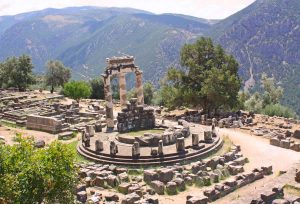 Located in the heart of Delphi, Greece, the Museum of Delphi is an archaeological museum that houses some of the most significant artifacts from ancient Greek history. Visitors can explore a wide range of exhibits that showcase the rich cultural heritage and historical significance of this region.
Located in the heart of Delphi, Greece, the Museum of Delphi is an archaeological museum that houses some of the most significant artifacts from ancient Greek history. Visitors can explore a wide range of exhibits that showcase the rich cultural heritage and historical significance of this region.
One of the highlights of the Archaeological museum in Delphi is its collection of ancient sculptures. From iconic statues such as Apollo to intricate carvings depicting scenes from Greek mythology, these sculptures offer a fascinating glimpse into the artistic traditions and beliefs of ancient Greeks.
Another must-see exhibit at the Archaeological Museum of Delphi is its collection on oracle bones. These ancient inscriptions were used by priests to predict future events and are an essential element in understanding how religion played a role in everyday life during those times.
The museum houses a remarkable collection of artifacts and artworks that were discovered in and around the archaeological site of Delphi. It showcases the rich history and cultural significance of the area, which was considered the center of the world by the ancient Greeks.
Visiting the Museum of Delphi is an opportunity to explore the wonders of ancient Greece and appreciate the artistry and craftsmanship of its people. It allows visitors to immerse themselves in the fascinating world of the Oracle of Delphi and gain a deeper understanding of this significant historical site.
Contents
Exibits of the Museum of Delphi
The exhibits at the Museum of Delphi are a fascinating insight into the ancient world and its mysteries. The museum houses an impressive collection of artifacts, dating from the 15th century BC to Roman times. The Dancing Column, the archaic kouroi Cleobis and Viton, Agias, athlete and winner in the pancratium and in all the Panhellenic competitions, the beautiful Antinous, metopes from the treasury of the Athenians, the halls of the temple of Apollo, etc. are included in the collections of the famous Delphi museum. Some of the notable exhibits in the Museum of Delphi include:
Charioteer of Delphi
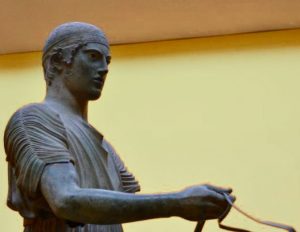 The Charioteer of Delphi is one of the most famous ancient Greek sculptures. It is a bronze statue created in the classical period around 470 BC and was discovered in 1896 near the Temple of Apollo in Delphi, Greece. The statue depicts a charioteer standing upright and holding the reins of his chariot.
The Charioteer of Delphi is one of the most famous ancient Greek sculptures. It is a bronze statue created in the classical period around 470 BC and was discovered in 1896 near the Temple of Apollo in Delphi, Greece. The statue depicts a charioteer standing upright and holding the reins of his chariot.
The Charioteer is notable for its exquisite craftsmanship and attention to detail. It stands at approximately life-size, measuring about 1.8 meters (6 feet) tall. The statue was originally part of a larger monument, possibly a victory dedication or a commemoration of a specific event. The charioteer’s precise identity remains unknown, as there are no inscriptions or other identifying features on the statue.
The sculpture is an excellent example of the Severe style of ancient Greek art, characterized by a sense of solemnity, idealized proportions, and an emphasis on naturalistic details. The Charioteer is depicted wearing a long robe or chiton, which falls gracefully and drapes around his body. The sculptor skillfully captured the subtle movement of the fabric and the tension in the charioteer’s body.
The face of the Charioteer is particularly striking. It is serene and composed, showing a sense of detachment and inner calm. The sculptor paid great attention to the facial features, including the detailed rendering of the eyes, which were originally inlaid with precious materials such as glass or gemstones.
The Charioteer of Delphi is considered a masterpiece of ancient Greek sculpture and is admired for its technical skill, artistry, and emotional depth. It is currently on display at the Delphi Archaeological Museum in Greece, where it continues to captivate visitors with its timeless beauty and historical significance.
Sphinx of Naxos
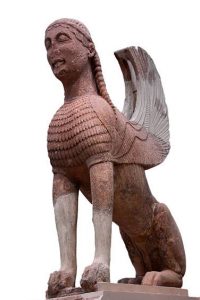 A large, fragmentary Sphinx statue from the Archaic period. It is one of the earliest known examples of monumental sculpture in Greece.
A large, fragmentary Sphinx statue from the Archaic period. It is one of the earliest known examples of monumental sculpture in Greece.
The sphinx was a vow of the Naxians and dominated the sanctuary of Apollo, on an Ionic column 12.10 m high. The mythical figure, a symbol of chthonic divinity and heavenly power, is represented with the body and legs of a lion, with the breast and wings of a bird and the head of a maiden. Her hair is long, taped across the forehead and falling in elaborate buns, while her demonic face is brought to life with large almond-shaped eyes and a coy smile, the era-typical ‘archaic smirk’.
Details of the anatomy and decorative elements on the chest and wings were indicated by engravings and color. The work is a typical example of Naxian sculpture in its heyday, the 6th century. e.g. The base of the sphinx was carved in 328-327 BC. resolution of Delphi, by which the Naxians were given the right of pre-oracle, i.e. the right to precede when receiving oracles from the oracle of Delphi.
Siphnian Treasury Frieze
The Siphnian Treasury Frieze of Delphi is a famous ancient Greek artwork that adorned the treasury building of the island of Siphnos at the Sanctuary of Apollo in Delphi, Greece. It was created in the 6th century BCE and is considered one of the finest examples of Archaic Greek sculpture.

The Siphnian Treasury was a small building constructed to house valuable offerings and dedications to the god Apollo. The treasury was built with marble and featured decorative friezes on its exterior. The frieze is a continuous sculptural band that wraps around the upper part of the treasury’s walls.
The frieze of the Siphnian Treasury depicts various mythological and historical scenes. It consists of multiple relief panels depicting gods, heroes, and mythical creatures engaged in various activities. The scenes depicted include the battle between the gods Apollo and Heracles with the giant Tityos, the abduction of Helen by Theseus and Peirithous, the fall of Troy, the Amazonomachy (battle of the Greeks with the Amazons), and the Centauromachy (battle of the Greeks with the Centaurs). These scenes are intricately carved and showcase the artistic skill and storytelling abilities of the ancient Greek sculptors.
The Siphnian Treasury Frieze is significant for its artistic and historical value. It provides insights into the mythological narratives and cultural beliefs of the ancient Greeks. The frieze also demonstrates the development of Greek sculpture during the Archaic period, showcasing the transition from the rigid and stylized forms of earlier periods to a more naturalistic and dynamic style.
Today, the original frieze panels of the Siphnian Treasury are no longer in their original location. They were removed and placed in the Delphi Archaeological Museum for preservation, while replica panels are displayed on the treasury building at the Delphi site. Visitors to the museum can admire the exquisite craftsmanship and storytelling of the Siphnian Treasury Frieze, which stands as a testament to the rich artistic legacy of ancient Greece.
Treasury of the Athenians
 The reconstructed remains of a treasury dedicated by the city of Athens. It features intricate architectural details and is a testament to the wealth and power of ancient Athens.
The reconstructed remains of a treasury dedicated by the city of Athens. It features intricate architectural details and is a testament to the wealth and power of ancient Athens.
The Treasury of the Athenians was a significant monument located in the ancient Greek sanctuary of Delphi. Delphi was renowned as the home of the Oracle of Delphi, a priestess who was believed to communicate with the god Apollo and provide prophecies and guidance to visitors.
The Treasury of the Athenians was one of many treasuries that were constructed by various Greek city-states within the sanctuary of Delphi. These treasuries served as repositories for valuable offerings and dedications made to the gods. They were often constructed in the form of small buildings, showcasing the wealth and artistic achievements of the city that built them.
The Treasury of the Athenians specifically was constructed by the city-state of Athens to house their offerings to the gods. It was built around 490 BC, following the Athenian victory at the Battle of Marathon. The treasury was dedicated to Apollo, the god of music, prophecy, and light, as well as Athena, the patron goddess of Athens.
The architectural style of the Treasury of the Athenians was influenced by the Ionic order, characterized by its decorative capitals (the top part of a column) and the presence of volutes (spiral scroll-like ornaments). The treasury was adorned with sculptures and friezes depicting mythological and historical scenes, showcasing the artistic skills of the Athenians.
Kouroi of Delphi
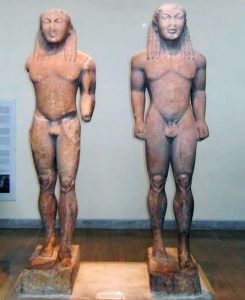 The Kouroi of Delphi, also known as the Delphi Kouros statues, are a group of ancient Greek sculptures that were discovered near the Sanctuary of Apollo in Delphi, Greece. Delphi was a significant religious and cultural center in ancient Greece, and it was the site of the famous Oracle of Delphi, where people sought advice and prophecies from the god Apollo.
The Kouroi of Delphi, also known as the Delphi Kouros statues, are a group of ancient Greek sculptures that were discovered near the Sanctuary of Apollo in Delphi, Greece. Delphi was a significant religious and cultural center in ancient Greece, and it was the site of the famous Oracle of Delphi, where people sought advice and prophecies from the god Apollo.
The Kouroi (singular: kouros) are freestanding sculptures of young male figures that were created during the Archaic period of ancient Greece (approximately 700-480 BCE). They are characterized by their rigid frontal poses, with the arms at their sides and one leg slightly forward, a convention known as the “archaic smile,” and stylized, geometric features.
The Delphi Kouroι statues were found in the vicinity of the Temple of Apollo, which was the central building in the Sanctuary of Apollo. They were made of Naxian marble, a type of marble sourced from the island of Naxos. The statues range in height from around 1.80 to 2.20 meters (5.9 to 7.2 feet).
Unlike some other kouroi from the Archaic period, the Delphi Kouros statues are not inscribed with dedicatory or commemorative inscriptions, making it difficult to determine their exact purpose or meaning. It is believed that they were created as votive offerings or representations of deities or heroes. Some theories suggest that they might have been dedicated to Apollo, but this cannot be confirmed.
The Delphi Kouros statues are considered excellent examples of Archaic Greek sculpture. They showcase the development of early Greek art, transitioning from the rigid, stylized forms of the Archaic period to the more naturalistic and lifelike representations of the Classical period.
The Sanctuary of Apollo
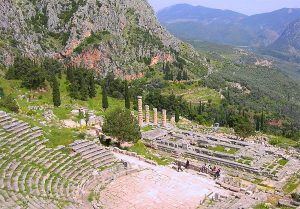 The central and most important point of the archaeological site has always been the sanctuary of Apollo. It was protected by an enclosure, with an entrance in its south-east corner. From this point the visitors followed the Sacred Way, the main structure of the mosque, which led to the temple of Apollo with the famous shelter, where the Pythia gave her oracles.
The central and most important point of the archaeological site has always been the sanctuary of Apollo. It was protected by an enclosure, with an entrance in its south-east corner. From this point the visitors followed the Sacred Way, the main structure of the mosque, which led to the temple of Apollo with the famous shelter, where the Pythia gave her oracles.
According to mythology, the first temple of Apollo built in Delphi was a hut made of laurel branches, the second was made of beeswax and feathers, and the third was made of copper, while the fourth was built by the mythical architects Trophonius and Agamides with the help of of Apollo himself. This must have been the ancient temple, which was destroyed by fire in 548 BC.
The temple that succeeded it was built in the 4th century BC. on the foundations of an older temple that was destroyed in 373 BC. from an earthquake. The inside of the temple was decorated with frescoes, while the outside had sculptural decoration and gilded Persian shields, spoils from the battle of Marathon.
The Sacred Way of Delphi
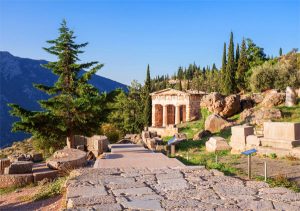 The Sacred Way, between the museum and the Castilian spring, which wound its way up to the temple of Apollo and the altar of Chios, the polygonal wall of Delphi in front of which stood the Stoa of the Athenians – an Athenian dedication to house the city’s navy of the trophy-, the treasure of Siphnia – one of the most brilliant and richly decorated buildings in the sanctuary of Apollo-, the ancient theater of Delphi inside the sanctuary of Apollo, with a capacity of 5,000 spectators, which was built in the 3rd century BC. made of Parnassos stone and in ancient times the dramatic and musical competitions of the Pythians were held and even higher, outside the precincts of the Sanctuary, the Stadium that hosted the sports competitions are included in the monuments of the archaeological site of Delphi.
The Sacred Way, between the museum and the Castilian spring, which wound its way up to the temple of Apollo and the altar of Chios, the polygonal wall of Delphi in front of which stood the Stoa of the Athenians – an Athenian dedication to house the city’s navy of the trophy-, the treasure of Siphnia – one of the most brilliant and richly decorated buildings in the sanctuary of Apollo-, the ancient theater of Delphi inside the sanctuary of Apollo, with a capacity of 5,000 spectators, which was built in the 3rd century BC. made of Parnassos stone and in ancient times the dramatic and musical competitions of the Pythians were held and even higher, outside the precincts of the Sanctuary, the Stadium that hosted the sports competitions are included in the monuments of the archaeological site of Delphi.
Dome of Athena Pronaia
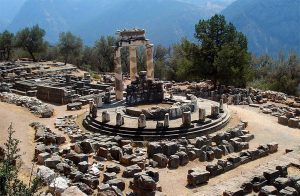 The Dome of Athena Pronaia situated within the sanctuary of Athena Pronaia between the temple of Athena and the treasury of Marseli. Its classical architecture is impressive, although its purpose remains uncertain. It has been linked to chthonic worship, though famously even the traveler Pausanias did not describe it as a temple upon visiting its ruins in 2nd c. A.D. The circular structure itself dates back to 380 BC and was designed by Theodore from Phocaea or Phocis who had even composed a book on how it was created.
The Dome of Athena Pronaia situated within the sanctuary of Athena Pronaia between the temple of Athena and the treasury of Marseli. Its classical architecture is impressive, although its purpose remains uncertain. It has been linked to chthonic worship, though famously even the traveler Pausanias did not describe it as a temple upon visiting its ruins in 2nd c. A.D. The circular structure itself dates back to 380 BC and was designed by Theodore from Phocaea or Phocis who had even composed a book on how it was created.
The Dome of Athena Pronaia brings a synthesis of classical architectural designs into one building. The twenty outer columns are classically designed in Doric fashion, topped with frieze and metopes depicting the Amazon battle and Centaur battle reliefs. Inside the circular nave, low solid walls were capped by another Doric frieze with triglyphs and smaller sized metopes, which were interspersed between Corinthian semi-columns.
To lift the entire building up from its platform of three lower tiers, a combination of various materials was used, such as Parian and Pentelic marble, and also Eleusinian limestone to give emphasis to structural details within the masonry and on the flooring. The roof was marble constructed and some rhomboid panels still remain of its decoration.
Presently, it’s hard to accurately restore two rows of sims into its original roof form; a conical shape known as Chinese hat model is hypothesized instead. Additionally, it is speculated that capes shaped like women in an almost dancing motion may have adorned the top layer. Unfortunately, these details are now lost given their use for Christian service later on.
History of the Museum
In 1903, Tournaire, a French architect, was commissioned to construct the first museum of Delphi, which consisted of two wings and was funded by A. Sygrou’s donation. By 1935-1936, repairs and expansions had taken place before two years later the re-exhibition of the antiquities commenced, thanks to the collaboration of Greek and French archaeologists. Further development was done in 1956 with a warehouse for inscriptions being erected; however, a complete renewal occurred in 1958, being necessitated due to the concealment of ancient items during German occupation as well as conforming to current expositional philosophy standards.
In the summer of 1958, Patroklos Karatinos developed plans to begin work on the museum. Two new rooms were added; one for small metal objects and the other for Hiniochos. The three existing rooms also underwent remodeling, with former storage areas becoming offices, a guest house, and a warehouse. In front of these offices a portico was created, displaying statues from the Hellenistic era (the portico was closed in 1980 due to the expansion of the offices of the Ephoria). Nearby warehouses and workshops for sculptures, pottery and architectural members were built too. Lastly, re-exhibition of ancient artifacts took place from 1960 – 1963.
In 1975, the sculpture workshop and warehouse were partially converted into a hall for exhibiting bull sculptures and chryselephantine objects discovered in the Holy Way deposit. The hall was finished and opened in 1978. In December 1979, a second staircase was constructed for visitors upon entering the building. Further renovations were completed to the museum in 1999, which included new laboratory spaces, a warehouse, offices, reception areas, canteen and sales office; modernization of existing exhibition spaces; improvements to the architecture of the building such as roofs and floors; and modifications to outdoor areas.
During this period, re-exhibitons of the museum’s collection took place with new public service areas created; exhibits highlighted and further enriched with additional material; an up-to-date background established through use of modern technology; greater exhibition potential enabled through reorganization of displays according to a new museological concept.
How to get to the museum of Delphi
Visiting the Museum of Delphi is a must-do activity for anyone interested in ancient Greek history and culture. With its impressive collection of artifacts, statues, and historical objects, it offers visitors a unique opportunity to learn more about the rich heritage of this fascinating region.
If you’re planning on visiting Greece anytime soon, make sure you include the Museum of Delphi in your itinerary. To get there, you can either take a bus from Athens or Thessaloniki (the two closest major cities), or rent a car and drive yourself.
The journey takes around 2-3 hours by bus or around 2 hours by car. Once you arrive at the museum, simply purchase your tickets and start exploring! You’ll be amazed at all the incredible exhibits on display here.
